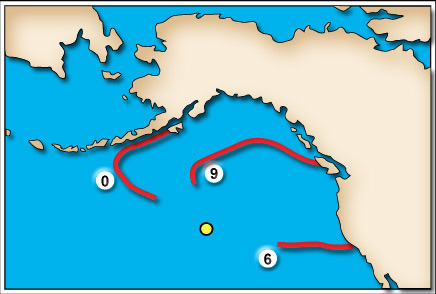
e.3 - Effect of the magnetic declination.
When the magnetic declination is different from zero.
========================================================
© copyright notice ||| français ||| italiano
prologue > index > Force d and magnetism.
e.1 “Force d” and magnetism: introduction.
e.2 Meridians: common and magnetic.
e.3 Effect of the magnetic declination.
e.4 Anomalous tides - introduction.
e.5 Early tides, late tides.
e.6 Aborted tides.
e.7 Only one system at a time.
========================================================
The cotidal lines - the lines drawn on a chart and representing high waters that occur at the same time - appear to be bent as a function of the magnetic declination that varies from one place to another one.
In places (of the northern hemisphere) the more the magnetic declination is negative (when the angle measured is west), the more the tides come early; the more the magnetic declination is positive (when the angle measured is east), the more the tides are late.
The effect of the magnetic declination on the times of the tides is easily seen in tidal basins located not far from one geographic pole, and where the magnetic declination varies substantially over a short distance.
Example.
An example is found in the north east basin of the Pacific Ocean (see map below). The magnetic declination is east everywhere in the basin, reaching the highest values in the north-east part of it, where the tides show to be late with respect to what occurs in the rest of the basin.
The delay increases near the coast, as the thrust fronts get transfomed into components of a tidal wave, much slower.

In the map above the red lines stand for the high water wave at the passage of the Moon on the meridian (0), six hours later (6) and nine hours later (9) (the tide moves counterclockwise because the area is in the northern magnetic hemisphere).